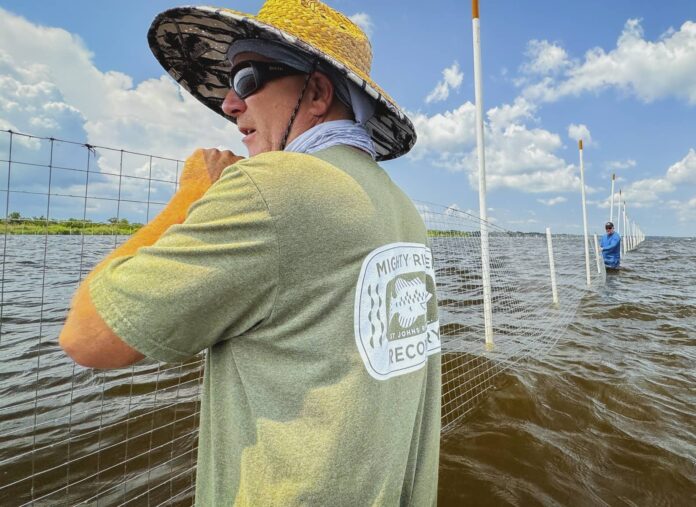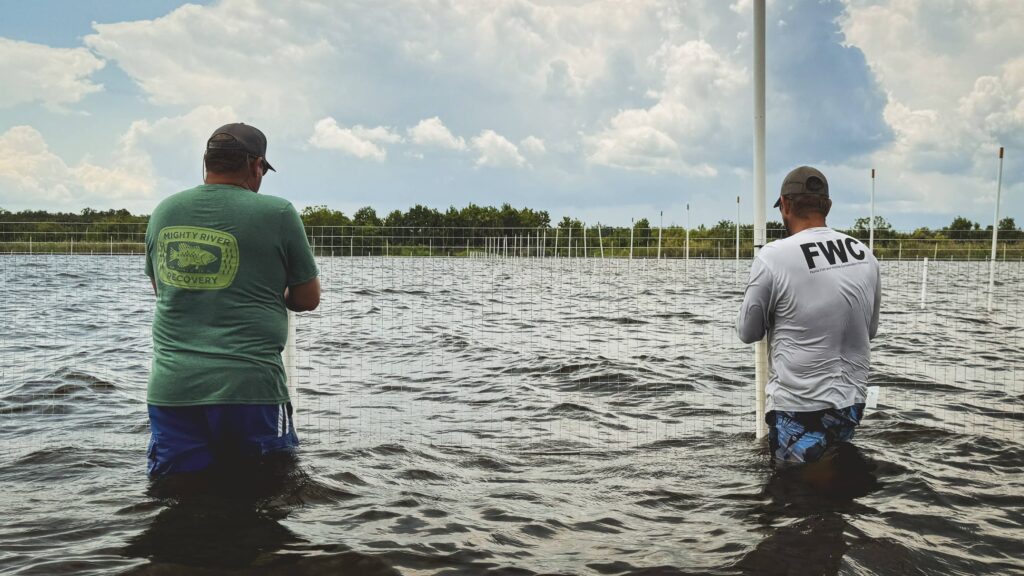
In the foreground, Joe Balog of Mighty River Recovery constructs a vegetation enclosure.
BY JOE BALOG
A recent volunteer effort got me thinking about the future. Everywhere I turned, helpers prioritized the health of the St. Johns River.
Waist-deep in the murky water, newcomers to the effort were understandably leery. Wading around in waters known for giant alligators can get anyone concerned, especially when you can’t see your toes. But the volunteers just kept working. Safety was in numbers.
The objective was to enclose large tracts of the Lake George shallows with stainless-steel fences. This particular project spanned 10 acres of barren bottom, once a beautiful waterway supporting a carpet of submerged vegetation. These “weed beds” were primarily native eelgrass, essential links in the chain of life.
The vegetation left our river in small steps, then with one great rush, following the flood events of 2017 and 2018. Restoring the plants makes for a great volunteer effort — and one many of us in West Volusia can take part in this summer.
The restoration forms a massive project initiated by the Florida Fish and Wildlife Conservation Commission, and through coordinated efforts by groups like the St. Johns Riverkeeper and our own Mighty River Recovery.
Many of you will recognize yours truly as the executive director of Mighty River Recovery, a nonprofit started in DeLand specifically to take on the noted decline of the St. Johns River. As a group, we’re concerned about a number of issues, but see vegetation growth as a current priority.
I’ll explain how to get your feet wet and join the cause in a minute. First, a little more background.
For as long as anyone can remember, vegetation has existed in the shallow waters of the St. Johns River. The submerged grasses — those rooted to the bottom — began disappearing decades ago, for reasons unknown. At first, the loss was a slow trickle. Through the high waters of our most recent floods, any remaining vegetation was wiped out.
Massive Lake George — once ringed with a carpet of eelgrass — was left totally void. Farther downstream, areas also vibrant for centuries turned into underwater deserts.
Now, this wasn’t the first time vegetation in the St. Johns River disappeared. What was different, however, was that it never grew back.
With a handful of growing seasons in the books, the FWC set out to learn more. Through mask and snorkel sampling, it was determined that the grass beds were, in fact, growing back. But something was eating them as fast as they grew. Initial observations blamed turtles, maybe manatees and fish.
Since that time, the FWC has enclosed hundreds of acres of shallow water throughout the St. Johns River with small-mesh fencing, prohibiting the grass-eaters from entering. Almost immediately, in nearly every enclosure, the native plants grew back.
The plan now, it seems, is to enclose so much of the river that, once the eelgrass and other plants establish, the fences can come down. So much vegetation will be in the system that the weed eaters can eat to their heart’s content without making a dent. Once in mass, the vegetation will grow faster than it’s being consumed, just as it always did.
Seems reasonable. Again, we’re involved, and hope you can be, too. Nothing positively impacts the natural ecosystem more than plants. At least a dozen volunteer efforts will be coordinated in 2024 from Jacksonville to Enterprise. It’s easy to stay abreast on the social pages and website for Mighty River Recovery.
Building the enclosures is both fun and wildly gratifying. Volunteer groups come from all walks of life, men and women, young and old. The only work prerequisite is the ability to operate a zip tie. Nothing could be simpler.

Most times coordination is led by Tim Mann, a bass angler turned lifetime river advocate from St. Johns. Tim also serves as a board member for Mighty River Recovery. Messaging us can get you to him, and get your boots on the ground, or in the water.
This is not a cure-all; we recognize that. Concerned about the overall health of the St. Johns, we’re already looking down the road, asking the difficult questions.
Wondering why vegetation now struggles to grow? Investigating the impact of management. Learning more about invasive vegetation and exotic fishes taking refuge in our waters.
Questioning the effects of massive development?
We also get the tough questions.
Why, our members ask, would the government want to grow vegetation on our river when they so often seem determined to kill it? Regular users of Florida’s freshwater playgrounds have opinions of the aggressive measures used to control weeds, where “spray boat” is a less-than-flattering term.
Here, I’ll tell you, it’s different. While far from ideal, those aggravating control methods are used for invasive, non-native plants. In this case, it’s native plants being grown. Enclosing areas to help has proved successful. Photos of substantial growth after just six weeks are impossible to argue with.
The early regrowth efforts concentrated on areas to our north. From Palatka to Jacksonville, structures have been erected to grow submerged aquatic vegetation. The effort has spread to Lake George, and groups like ours are lobbying to bring the same efforts closer to home.
If you love the St. Johns River like we do, you’ll want to be more involved. Later this month, Mighty River Recovery is hosting two community meetings at Highland Park Fish Camp to discuss the current projects, or any other concern you may have. During these live sessions, you can learn the mission of our group, and how we plan to get there. We’ll answer your tough questions, too, and give you more information on the struggles ahead.
Mighty River Recovery believes this is the most critical time in history to restore and protect the St. Johns River. I hope to see you out there.